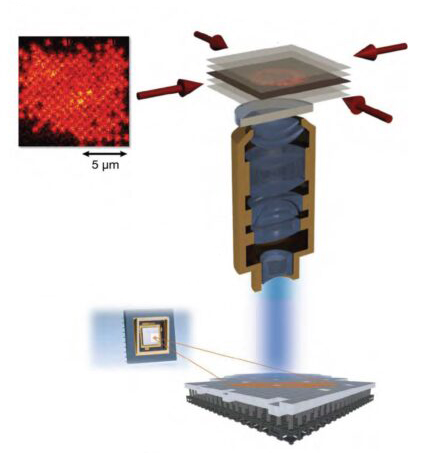SMAQ - Scalable Optical Modulators for Atomic Quantum Computers (SMAQ)
Together with the Max Planck Institute of Quantum Optics, we are working on a joint project as part of the “QNC Space” - the Deep Tech Accelerator for research groups, start-ups and SMEs in the field of quantum and neuromorphic computing. The QNC Space is part of the “Research Fab Microelectronics Germany - Module Quantum and Neuromorphic Computing” (FMD-QNC), a joint project of the 13 FMD institutes, the four Fraunhofer Institutes ILT, IMWS, IOF and IPM, as well as Forschungszentrum Jülich and AMO GmbH.


Quantum computers based on charged or neutral atomic qubits offer a number of advantages over alternative technologies, in particular the intrinsically high quality of the qubits and the excellent coherence times and gate qualities that can be achieved.
The realization requires a high degree of control over focused laser beams and represents one of the greatest challenges in atomic quantum computers. Devices for generating the focused laser beams include laser systems, components for fast, scalable and programmable modulation of light intensity or phase, and high-resolution imaging optics for generating nearly diffraction-limited laser spots. So-called SLMs (spatial light modulators) are used for the programmable modulation of light intensity or phase. In order to enable scalable and efficient quantum computing processes, these components must also be suitable for specific wavelength ranges.
In the SMAQ project, we are specifically developing phase-shifting, diffractive, perpendicular-mirror MEMS SLMs for use in neutral-atom quantum computers. The technology of MEMS-SLMs opens up new dimensions in terms of precision and scalability. This project is a first important step on an emerging new technology path for further scaling of neutral atom quantum computers.
Advantages
The use of MEMS technology offers a number of advantages over the liquid crystal-based modulators currently commonly used for such applications, e.g.
- Unique access to the previously unexplored ultraviolet (UV) spectral range. The project also provides a scalable research approach. The wavelength reduction enables denser atomic qubit registers.
- the minimization of crosstalk between individual modulator pixels. This avoids currently known problems of resolution reduction in conventional modulators based on liquid crystal arrays.
- the high speed potential of MEMS SLMs up to the megahertz range, which offers the possibility of agile control of individual addressing beams and thus also opens up prospects for future projects.
- the potential of a further, previously inaccessible degree of freedom of control over polarization.
Development work of the Fraunhofer IPMS in the project
The development work covers the entire MEMS-SLM value chain:
- Realization of the integrated CMOS drive circuit (backplane): Circuit design, simulation and processing in the in-house pilot production line
- Development of the MMA and the associated MEMS actuator technology: Actuator design, simulation of the electromechanical behavior, analytically and using the finite element method (FEM) and process development for monolithic integration on active control circuits in CMOS-compatible surface micromechanics)
- Chip packaging
- Electrical, mechanical, optical and application-related characterization of CMOS and MEMS parts at wafer and chip level
- External control electronics and data interface (hardware and software) for MEMS-SLM operation
 Fraunhofer Institute for Photonic Microsystems
Fraunhofer Institute for Photonic Microsystems